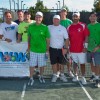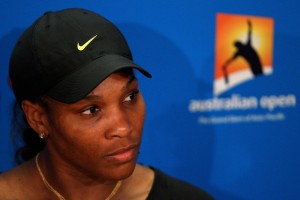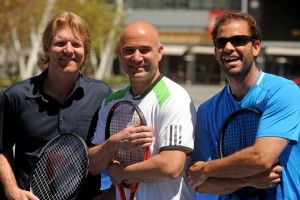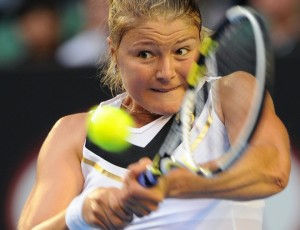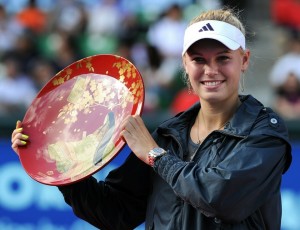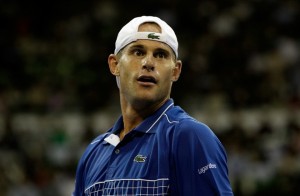By Randy Walker
@TennisPublisher
What are some of the most lackluster and boring U.S. Open men’s finals of all time?
I was trying to think of the answer to this question while absorbing the beginning stages of the 2019 U.S. Open men’s singles final between Rafael Nadal and Daniil Medvedev. With Nadal the overwhelming favorite, going for an historic major title No. 19, having lost only one set en route to the final and no nagging injuries bothering him, he seemed certain to steamroll the newbie Medvedev, playing in his first major final, seemingly exhausted from a long grueling summer of tennis and fighting injuries and soreness during a difficult route to the final. Many players of his level sometimes seem satisfied with the overachieving result and this looked as though it would also be the case. To boot, Nadal dominated Medvedev 6-3, 6-0 in the Montreal final five weeks earlier.
In the U.S. Open media room before the final, International Tennis Hall of Fame member and “Greatest Tennis Matches of All Time” author Steve Flink and I discussed the final and we both thought maybe Medvedev could sneak out a set. Flink told me that he spoke with 1988 U.S. Open champion and Eurosport commentator Mats Wilander just minutes earlier who said he didn’t think Medvedev would even get that close.
The least interesting U.S. Open men’s final I could remember was 1986 when Ivan Lendl defeated Miloslav Mecir 6-3, 6-2, 6-0. Nadal’s 6-3, 6-3, 6-4 win over Kevin Anderson in 2017 was also pretty boring as was the Pete Sampras win over Cedric Pioline in 1993 by a drama-free 6-4, 6-4, 6-3 margin. The Nadal – Medvedev final seemed headed in this direction as the Spaniard took the first two sets 7-5, 6-3. “There’s no danger of this becoming an instant classic,” quipped John McEnroe on ESPN early in the match.
A few text messages came into my phone from friends watching the final. “This f*%*ing match is so boring” came one text. “This match is so bad” came another. “It’s all over. Now what? Do I have to watch the Giants?” read another after the first two sets from a friend who was now dreading that he would have to watch the dismal National Football League game between the Dallas Cowboys and the New York Giants.
At 4-4 in the third set, also bored, I thought I should get an early start on beating the crowd to the subway. I started to pack my bag to leave from the upper broadcast area high above Arthur Ashe Stadium. As I stuffed the three copies of “Racquet” magazine that Ben Rothenberg from the New York Times gave me earlier in the day, Nadal had 0-30 on Medvedev’s serve and was ready to feast on a second serve from the Russian. Medvedev was able to get to 30-30, but then after an exhausting 28-ball rally, he faced break point to allow for Nadal to serve for a routine straight-set win. Medvedev painted the line with a ground stroke to save that break point and then two points later, when faced with another break point, he lucked out when Nadal netted a relatively easy overhead off the bounce. Almost miracously, Medvedev held serve for 5-4. This would be a good time to escape to beat the crowds. It was a good thing I stayed.
What unfolded was one of the greatest U.S. Open men’s finals ever. Hanging on by the Kinesio tape skin of his teeth, Medvedev put together a few slap winners to break Nadal to win the third set 7-5. Medvedev fed off the energy of the New York City crowd who roared for him in their thirst to watch more tennis. The irony in the crowd screaming for the Russian was that he was booed like no one other player in the history of the event in his wins over Feliciano Lopez in the third round and Dominik Koepfer in the fourth round, stemming from him violently grabbing a towel from a ball person and giving the middle finger to the jeering New York crowd. He then trolled the booing crowd in his on-court post-match interviews, saying the boos inspired him to fight harder. “I won because of you!” he trolled while outstretching his arms and tilting his face to the sky to embrace the shower of boos. It was U.S. Open theatre at its best and Medvedev was immediately cast as a tennis villain worse than early Jimmy Connors or Ilie Nastase. Now, because of the desire of these New York fans wanting to see more tennis – and impressed by his effort – these fans were cheering at the top of their lungs for this 23-year-old Russian.
“Open crowds often do this, trying to will an underdog to make it a competitive match,” wrote Jason Gay in the Wall Street Journal of the final. “But there’s a difference between ‘I paid $300 for this ticket and I want to see more tennis’ cheering and ‘We actually love this guy’ cheering. What Medvedev got Sunday was the latter.”
“He’s gone from middle finger to standing ovation,” said Patrick McEnroe on ESPN.
In the middle of the fourth set, one of my friends texted me again. “Medvedev doesn’t look tired” he wrote. “A fifth set would be amazing. Does he have the stamina?” Medvedev kept fighting and showed that he could hang with the uber-fit Nadal. Incredibly, it was Nadal who started to show fatigue with more and more misses and controversial stalls before returning and serving. After Nadal incredibly mishit an easy forehand at deuce serving at 4-5, Medvedev struck an laser backhand return-of-serve down the line for a winner from way off the court off a curving lefty Nadal serve out wide. The match was tied at two sets apiece. The Arthur Ashe Stadium crowd erupted and an instant U.S. Open epic was at hand.
“Can you believe we are going five, because I can’t” said Jim Courier on Tennis Channel’s live-to-tape TV coverage of the final.
Medvedev had never won a five-set match in his life, but Nadal had never won the U.S. Open when he was extended to five sets at Flushing Meadows. His record when up two-sets-to-love at majors was 202-1, the one loss coming at the U.S. Open in this very court in 2015 against Fabio Fognini, a mercurial player not unlike Medvedev.
Down 0-1 early in the fifth set, Nadal saved two break points, one with a shot on the line and one after losing a first serve after a being penalized a first serve for not serving within the 25-second serve shot clock time frame. However, Nadal broke Medvedev to take a 3-2 lead in the final set and then again to take a 5-2 lead. The previous day, Serena Williams broke eventual champion Bianca Andreescu’s serve twice in a row when she served for the championship at 5-1 and 5-3 and Medvedev nearly did the same. He broke Nadal when serving for the match at 5-2 and had a break point when Nadal served for the match again at 5-4, but the Spaniard held on and finally closed out the match 7-5, 6-4, 5-7, 4-6, 6-4.
The match time was four hours and 49 minutes marking the third-longest U.S. Open final of all time, only eclipsed by Andy Murray’s 2012 U.S. Open final win over Novak Djokovic and Wilander’s 1988 win over Ivan Lendl, curiously both timed at 4:54, the longest finals in U.S. Open history.
“One for the ages,” tweeted Billie Jean King, certainly one who has seen her fair share of matches through the ages.
“There was nothing genteel about this match,” wrote Larry Brooks in the New York Post. “This turned into a brawl, no quarter given by either side featuring hours of intense, physical tennis. Medvedev got breaks and would not break. Nadal, the same. After two straight years of straight-set finals, this was one that will be remembered for ages.”
“Amazing” was the text I received from one of my earlier disgruntled tennis-watching friends.
It certainly was amazing and one for the ages. I’m glad I stuck around to witness it.



